
India has always proved its friendship with other countries during the crisis. On April 11, Indian medical rapid response team dispatched to Kuwait to assist the West Asian country’s in the fight against COVID-19 pandemic by helping in the testing and treatment of infected people.
Indian Government has created many such medical rapid response team following the COVID-19 outbreak to help the friendly countries to combat the coronavirus.
A team of 15 Indian Doctors and healthcare professional were sent at the request of the Kuwait Government.
The team will “supplement the efforts of the government of Kuwait in the collective fight against COVID-19 pandemic”, the external affairs ministry said in a statement.
The team, which was flown to Kuwait in an Indian Air Force aircraft, is expected to stay there for two weeks, during which it will “render medical assistance in testing and treatment of the infected people along with providing training to Kuwait’s medical staffs”, the statement said.
External Minister Dr S Jaishankar tweeted: “India’s RAPID RESPONSE TEAM arrives in Kuwait. Follow up to the discussion between our two Prime Ministers on #COVID19. Underlines the special friendship between India and Kuwait.”
India’s RAPID RESPONSE TEAM arrives in Kuwait. Follow up to the discussion between our two Prime Ministers on #COVID19. Underlines the special friendship between India and Kuwait. pic.twitter.com/lACVPTuqQj
— Dr. S. Jaishankar (@DrSJaishankar) April 11, 2020
“India is stretching out to Kuwait in the extended neighbourhood to further complement its attempts to fight the peril effectively,” the statement said.
India has already sent such similar teams to the Maldives and is planning to send another to Nepal.
The assignment of the Indian experts was followed by a phone call between Prime Minister Narendra Modi and his Kuwaiti counterpart Sheikh Sabah Al-Khaled al-Hamad al-Sabah on April 1, when the leaders agreed on collective and coordinated forces against the pandemic.
Subsequently, Foreign Minister S. Jaishankar and his Kuwaiti counterpart also had a telephone conversation to discuss the prevailing situation in Kuwait and explore ways to strengthen cooperation during these challenging times, the ministry said.
India and Kuwait have a strong partnership based on historical, cultural, economic and people-to-people-contacts. Indians constitute the largest group of emigrants in Kuwait, with an estimated population of about one million and their annual remittances, are estimated at 4.8 billion dollars.





